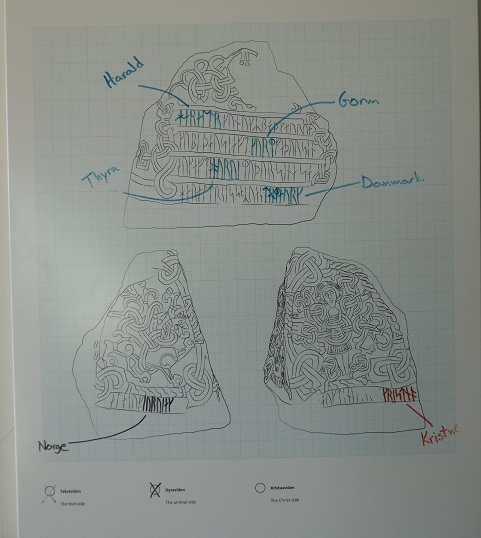Jelling in Denmark is an important archaeological site. It is considered as the birthplace of the Kingdom of Denmark. It is known for the Jelling stones and home of the Vikings.
Jelling is a small town in central Jutland in southern Denmark, about 10 km northwest of Vejle. Vejle is located just above the D in the word Denmark -
The Jelling Monuments was the first Danish site that was included on the Danish Unesco Heritage List : "The Jelling burial mounds and one of the runic stones are striking examples of pagan Nordic culture, while the other runic stone and the church illustrate the Christianization of the Danish people towards the middle of the 10th century."
Jelling was a royal monument during the reigns of Gorm, and his son Harald Bluetooth, in the 10th century. There are 2 important runic stones.
Gorm's stone - On the stone, the name of Denmark appears for the first time within the country. The stone was placed here c. 950 by Gorm the Old, in memory of his wife Thyra. The stones are protected in cases and it was hard to get photos because of the reflection in the bright sunlight.
Harald's stone - Harald Bluetooth Gormsson was a king of Denmark and Norway c. 958-986. He was the son of King Gorm the Old and Thyra Dannebod. He introduced Christianity to Denmark and consolidated his rule over most of Jutland and Zealand.
He had the rune stone hewn in c.965. It weighs over 10 tonnes. It tells of a time when the country was transitioning from a tribal society to a Christian kingdom. The stone has 3 sides. Harald writes that he is king of all the land and made the Danes Christian. The Danes call it Denmark's birth certificate. He honors his parents, proclaims he has won the crown of all of Denmark and Norway and states that he made the Danes Christian. To symbolise the change in religion, Harald had the image of Christ carved on one side. This is the earliest depiction of Christ in Scandinavia, with the inscription relating to the conversion of the Danes to Christianity between 953 and 965.
In the past the runes were read vertically but Harald changed this and had them carved horizontally as he had seen in the bible. This is the start of a new era.
This side shows a Nordic dragon -
This is the side showing Christ, photo from the museum display -
The current stone church is modern, previous wooden ones having burnt down. Bones of a man found in a tomb under the church floor were found in 1978 and may be those of Gorm the old. A small marker on the floor is the location of the tomb. The church organ -
There are 2 flat-topped mounds, 70 m in diameter and up to 11 m high, and almost identical in shape and size and construction. Harald's stone was originally between the mounds . Only the north mound contains a burial chamber (but no bones).
The south mound -
The white pillars mark the original wooden palisade. Harald had this built around the site, it was about 1.5 km long and made of solid oak. The flat stones are to represent the shape of a Viking boat, the 2 mounds are within the boat shape -
The north mound -

























No comments:
Post a Comment